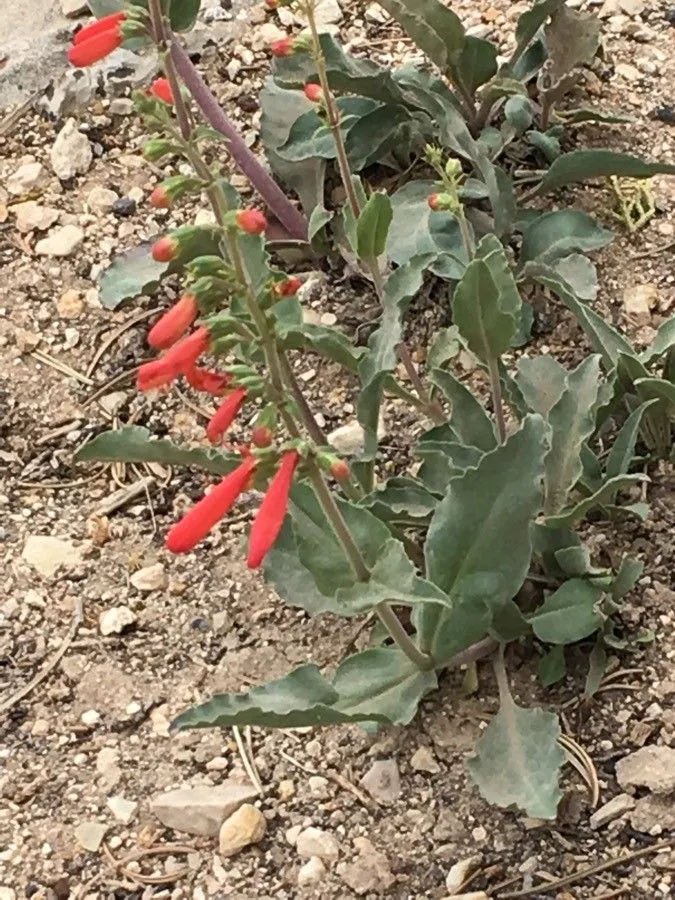
Author: A.Gray
Bibliography: Proc. Amer. Acad. Arts 8: 395 (1872)
Year: 1872
Status: accepted
Rank: species
Genus: Penstemon
Vegetable: False
Observations: W. & WC. U.S.A.
Eaton’s penstemon, scientifically known as Penstemon eatonii, is an enchanting flowering plant heralding from the rich botanical realms of the Western and West-Central United States. This striking species, belonging to the Plantaginaceae family, was first described by the renowned botanist Asa Gray in 1872 in the Proceedings of the American Academy of Arts.
Penstemon eatonii captivates with its brilliant red to orange tubular flowers, which emerge in late spring and continue into early summer. These vivid blossoms attract a plethora of pollinators, notably hummingbirds, drawn to the nectar-rich blooms. The plant itself is characterized by its robust, upright stems and narrow, lance-shaped leaves that provide a lush, green complement to the fiery flowers.
Eaton’s penstemon thrives in a variety of habitats, from desert shrublands to mountain meadows, demonstrating remarkable adaptability to different soil types and moisture levels. This resilience makes it an excellent choice for gardeners seeking a hardy perennial with low water requirements. Given its preference for well-drained soils and full sun exposure, Penstemon eatonii is particularly well-suited for xeriscaping and other sustainable landscaping practices.
In addition to its ornamental value, Eaton’s penstemon plays a crucial role in its native ecosystems. It supports local wildlife and enhances biodiversity by providing food resources and habitat. Gardeners and conservationists alike prize this plant not only for its aesthetic appeal but also for its ecological contributions.
To cultivate Penstemon eatonii successfully, one should mimic its natural growing conditions, ensuring ample sunlight and excellent drainage. While the plant is generally low-maintenance, occasional deadheading can prolong the blooming period and promote a more vigorous appearance.
Penstemon eatonii stands as a testament to the natural beauty and resilience of native flora. Its vibrant flowers and ease of growth make it a beloved choice among plant enthusiasts and a vital component of North American plant heritage.
Eng: eaton’s penstemon, firecracker penstemon
En: Eaton’s penstemon, Firecracker penstemon, Eaton penstemon
Taken May 20, 2020 by C T (cc-by-sa)
Taken May 31, 2013 by EOL − Steven Thorsted (cc-by-nc)
Taken Jun 28, 2020 by Rosemary Mugwort (cc-by-sa)
Taken Feb 22, 2019 by Daniel Barthelemy (cc-by-sa)
Taken Apr 23, 2020 by Brett Johanson (cc-by-sa)
© copyright of the Board of Trustees of the Royal Botanic Gardens, Kew.
Taken May 31, 2013 by EOL − Steven Thorsted (cc-by-nc)
Taken Feb 22, 2019 by Daniel Barthelemy (cc-by-sa)
Taken Jun 7, 2000 by EOL − Gerald and Buff Corsi (cc-by-nc-sa)
Taken Jun 11, 2010 by EOL − Gerald and Buff Corsi (cc-by-nc-sa)
Taken Jun 11, 2010 by EOL − Gerald and Buff Corsi (cc-by-nc-sa)
Taken Jun 11, 2010 by EOL − Gerald and Buff Corsi (cc-by-nc-sa)
Taken Feb 22, 2019 by Daniel Barthelemy (cc-by-sa)
Taken May 22, 2018 by Daniel Barthelemy (cc-by-nc)
Taken May 22, 2018 by Daniel Barthelemy (cc-by-nc)
Taken Aug 9, 2009 by EOL − Steve Matson (cc-by-nc)
Growth form>: Single Stem
Growth habit>: Forb/herb
Growth rate>: Rapid
Ph maximum: 8.0
Ph minimum: 7.0
Family: Myrtaceae Author: (F.Muell.) K.D.Hill & L.A.S.Johnson Bibliography: Telopea 6: 402 (1995) Year: 1995 Status:…
Family: Rubiaceae Author: Pierre ex A.Froehner Bibliography: Notizbl. Bot. Gart. Berlin-Dahlem 1: 237 (1897) Year:…
Family: Sapindaceae Author: Koidz. Bibliography: J. Coll. Sci. Imp. Univ. Tokyo 32(1): 38 (1911) Year:…
Family: Asteraceae Author: A.Gray Bibliography: Pacif. Railr. Rep.: 107 (1857) Year: 1857 Status: accepted Rank:…
Family: Fabaceae Author: Medik. Bibliography: Vorles. Churpfälz. Phys.-Ökon. Ges. 2: 398 (1787) Year: 1787 Status:…
Family: Aspleniaceae Author: (Cav.) Alston Bibliography: Bull. Misc. Inform. Kew 1932: 309 (1932) Year: 1932…